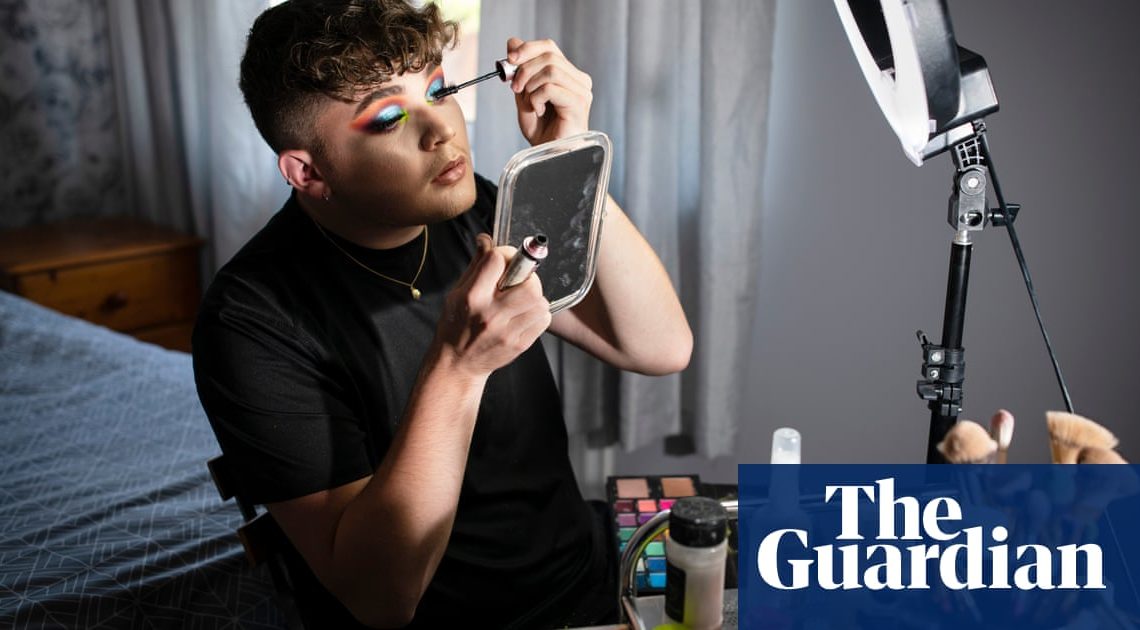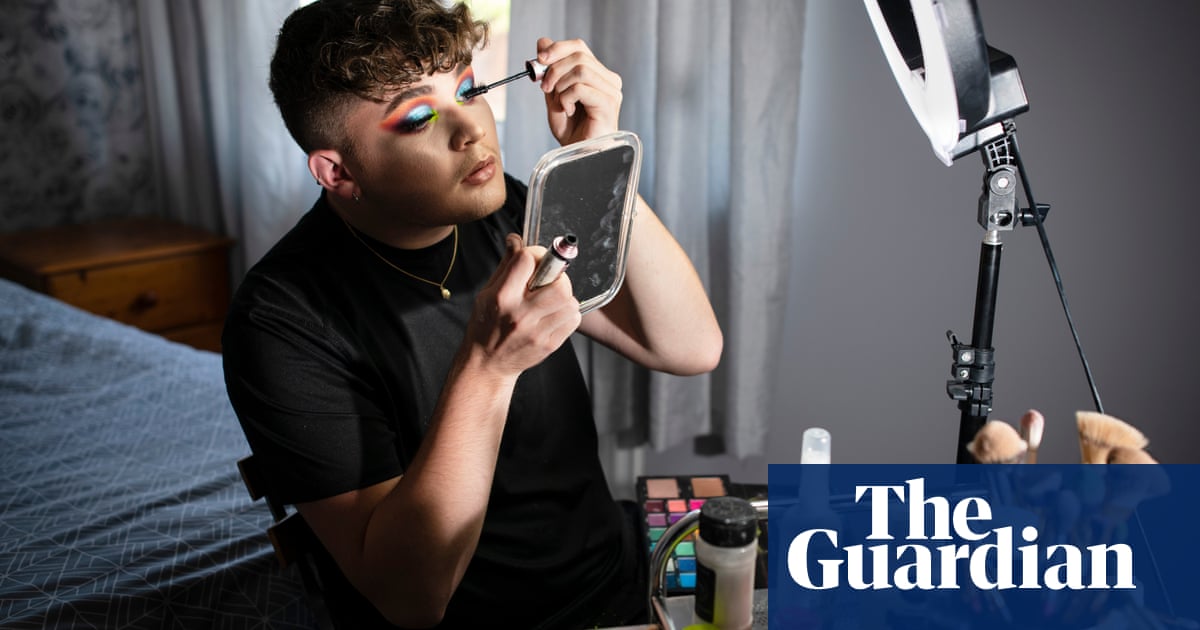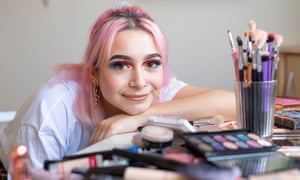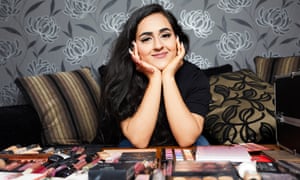
Extreme makeup: how the girls and boys of Generation Z created a huge new subculture
September 2, 2019Many young people now spend hours in their bedrooms, perfecting extraordinarily intricate looks to put up online

Its literally art! exclaims 16-year-old Milly Provenzano, sitting cross-legged on her single bed. Her eyeshadow is like the plumage of a tropical bird: blue, pink and yellow, to match the rainbow lettering on her Pride T-shirt. On the wall above her, Provenzano has taped up photographs of her favourite Instagram makeup stars: drag artist Hungry, famed for transforming Bjrk into a vagina-flower hybrid for the cover of her Utopia album, and Antoinette Mahr, whose trademark multicoloured style was clearly the inspiration for Provenzanos look today. I have asked the teenager from Kettering, Northamptonshire, to justify the many hours she spends alone in her room, perfecting fabulously complicated makeup looks. Thats like saying to someone who does A-level art and is painting all the time, Oh you shouldnt be doing that, you should be doing something more academic. Its just art, but its on your face.
Pulling out her phone, Provenzano shows me a list of makeup looks she would like to master. Her inspirations are diverse and obscure. Id really like to do an Error 404-inspired look, she muses. You know when something glitches online? Its mainly black and white, but also green and red. I browse the list what does the eyebrow slits but everywhere entry mean? Ive already done that one! she says. Id just given myself an eyebrow slit, and I woke up in the middle of the night and thought, why not do it everywhere on my face? So I got a tiny brush and concealer, and drew lines through my makeup.
Provenzano shows me a photo. Her eyes are orange. Her cheeks are a garish pink. There are thin lines down her face, as if her makeup has been stencilled around them. It is enormously impressive. After she finished the look, Provenzano uploaded a picture to Instagram, then washed the makeup off. Sometimes I keep it on if I really like it, she shrugs. Then a few hours later, Ill take it off.
Once, young people used makeup as visual code to gain admittance into different subcultures: black lipstick for goths, winged eyeliner for punks. Now, makeup is a subculture all of its own. In communities centred around Instagram and YouTube, young people gather virtually to look for inspiration, swap product tips and master tricky techniques. They often come to makeup through superstar vloggers such as NikkieTutorials (12.2m subscribers), Jeffree Star (15.6m subscribers) and James Charles, who boasts 15.9m subscribers, despite a series of scandals, one of which involved his former mentor releasing a 45-minute video claiming he had pressured heterosexual men to go out with him (claims he denied in another video), temporarily losing him millions of followers.

Beauty is big business. The market research firm Mintel valued the UK beauty and personal care market at 10.2bn in 2018. Spending is up: 30% of women aged 16-24 say they shell out more than they did 12 months ago. Brands that work with popular influencers to corner the teen market will experience phenomenal growth earlier this year, thousands of teenagers mobbed an appearance by Charles at the Birmingham store of the cosmetics brand Morphe. (The city was gridlocked for hours.) Popular makeup conventions such as Beautycon or Imats (the International Makeup Artist Trade Show) draw thousands, while young people compete on shows such as the BBCs Glow Up to be recognised as Britains freshest makeup talent.
In this community, your face is a canvas for incongruous, dreamlike, wearable art. All you need is some pocket money and a smartphone. But what is fascinating about this new subculture is that it is not taking place in crowded moshpits or twilit parks, but quietly in bedrooms. I dont go out much, says Provenzano. My friends come here or we go to their houses but we dont really go places.
Aiman Sheeraz, a 17-year-old from Manchester, says: My favourite skill is blending. This is what YouTube has taught me to blend my life away. Sheeraz got into beauty because of her mum, who loved makeup. Wed watch Asian bridal makeup tutorials and try to recreate them together. Looking back at the pictures, they were so horrific!
After her mum died two and a half years ago, Sheeraz started doing makeovers on her family and friends, posting the results online. I thought, why not get my talent out there? At first, Sheeraz did the makeup thing to honour her mum. But soon it took on a life of its own. It was never what I wanted to do full-time, says Sheeraz, who is studying for an apprenticeship in accountancy. Its more something to do on her behalf and make her happy. But now I really enjoy it myself. I guess Im doing it for her in a way.
As with any subculture, there are different tribes. Fans tend to divide into two camps: the first are lovers of the haute-glam look popularised by the Kardashian-Jenners and makeup artists such as Mario Dedivanovic and Kevyn Aucoin. Sheeraz falls into this category, describing her style as Asian glam: a very glowy base, full coverage, bright lips and eyes, but also something that you can wear to weddings and events it wont just look nice in pictures. Meanwhile, creative makeup fans prefer art-driven, colourful looks. With creative makeup there arent many rules, you can do what you want, says Niamh Dunne, a 19-year-old supermarket worker from Corby, Northamptonshire. Dunne takes inspiration from films or TV shows such as Stranger Things. After the Lion King reboot came out, she freehand-painted the amber and ochre colours of an African sunset on her chest. It took three hours.
Critics may say that young people shouldnt be messing around with blusher they should be focusing on their careers. But this is wildly missing the mark: beauty is a very lucrative career choice. Just ask Kylie Jenner, who built a billion-dollar fortune off the back of her cosmetics company (although sales are rumoured to be down). Of the 80 women on Forbess so-called self-made women rich list this year, 10 are from the makeup and skincare industries.
Sheeraz wants to become like her idol, the beauty mogul Huda Kattan. Being a woman of colour and getting to where she is from being an average person is really inspirational to me.
I wonder if any of the teens think it may be damaging to be so focused on their appearance. They all bat those concerns away. Most of the time Im actually barefaced, Sheeraz says. When I go to work, I dont wear it, because Id rather spend the time sleeping. Dunne agrees: With teenage girls, there is so much pressure on the way you look getting surgery and lip fillers and all of that stuff, she says. I dont think it should be like that. I dont wear it because I think I need it. I wear it because I enjoy doing it.
It is not just girls who are perfecting makeup techniques youve never heard of, such as halo brows or lollipop lips. Brands such as Milk Makeup and Fluide have created genderless cosmetics ranges, while legacy players including Chanel and Givenchy have launched male lines. They are targeting consumers like 17-year-old Matt Tierney. I remember sneakily telling my mum I had a Halloween party to go to when I was 14, so we could go to Superdrug and buy some makeup. She asked, Are you sure this is for Halloween? He laughs. Through YouTube, Tierney built up the confidence to experiment with makeup. If I didnt see people doing it online, Id never have gotten into it. I live in a little village in Northamptonshire. Ive never seen anyone walking around with a rainbow eye or in drag. You dont see that here.

Of course, marketing makeup to men doubles the amount of product brands can sell. And there is no doubt that consumerism is at the heart of this subculture to an alarming extent. Provenzano takes me to her local Superdrug. If Im in town, Ill come in to have a look, she says, fingering a yellow Revolution eyeshadow lovingly. (Provenzano favours affordable brands although she has a few high-end eyeshadow palettes by the US brand Lime Crime that arent tested on animals.) Makeup influencers such as Jaclyn Hill have landed themselves in trouble with their young fanbases over the quality of their products in one case, her lipstick was said to contain metal shards. Tierney bought the James Charles x Morphe palette after seeing it hyped online. I didnt think it was that great, to be honest. Maybe everyone saying it was amazing was on his payroll.
Regulators have started to step in. In the US, the Federal Trade Commission wrote to high-profile influencers to warn them against stealth shilling, where they fail to disclose they are being paid by brands. Earlier this year, the UKs Competition and Markets Authority secured formal commitments from celebrities to be more transparent about paid-for endorsements.
Even then, young people may not be able to recognise when their favourite online makeup artists are pushing products because they are paid to advertise them. What we see in the research is that they dont really recognise the advertising in vlogs or on Instagram as advertising, as much as they do on TV, warns Steffi de Jans of Ghent University. She characterises most beauty vlogs as effectively advertising: the vloggers are either being paid by the brand directly, or receiving free products. And this isnt just a 30-second cereal advert in a commercial break. Its hours and hours in a row of advertising messages, and theyre really engaging with it.
Subcultures have always been consumer-adjacent: you buy records, safety pins, miniskirts. But the act of consumerism isnt peripheral to this emerging beauty subculture its integral to it. This is consumerism as subculture. Sheeraz estimates she has spent about 1,000 on products from brands including Anastasia Beverly Hills and Huda Beauty, whose palettes retail for 40 to 60. Can a community that is so predicated on consumer consumption truly be considered a subculture?
Probably not, says Dr Rehan Hyder of the University of the West of England, explaining that it is better to think of these teenagers according to the concept of creative fandom, as coined by academic Henry Jenkins. Fans arent just consumers, but producers. Theyre not participating passively, but creating a community in which you share expertise, skills and collective intelligence. In the beauty world, they use makeup to establish themselves as persons of influence and skill like Tierney, who aims to achieve 100k followers. That would be a massive milestone, he says.
As teenage pursuits go, however, it is hard to think of a more clean-living way for young people to be spending their time a bottle of shoplifted vodka being passed around a park this is not. Im not really a going-out person, says Dunne. You just get hungover and cant be productive the next day. Tierney thinks that makeup gives young people something to do. Its quite wholesome, he laughs. People who have no lives, sitting in their room with a ring light on, blending makeup on their eyes! (He recently got one of these lights himself.)
Ring lights, contour kits, an arsenal of brushes to make Picasso blush: for teenagers today, makeup isnt a superficial hobby, but a way of expressing their creativity, hopes and dreams. Back in her bedroom, Provenzano does my makeup while telling me about her ambitions for the future she aspires to be a makeup artist for fashion shows. Going to London, she says dreamily, eyeshadow brush in hand. The fashion weeks Milan, London, Paris. Obviously I cant stay in Kettering and do runways, because its so small. And as she applies my eyeshadow with precision of a surgeon performing keyhole surgery, I close my eyes and think: Youll get there.
Read more: http://www.theguardian.com/us

